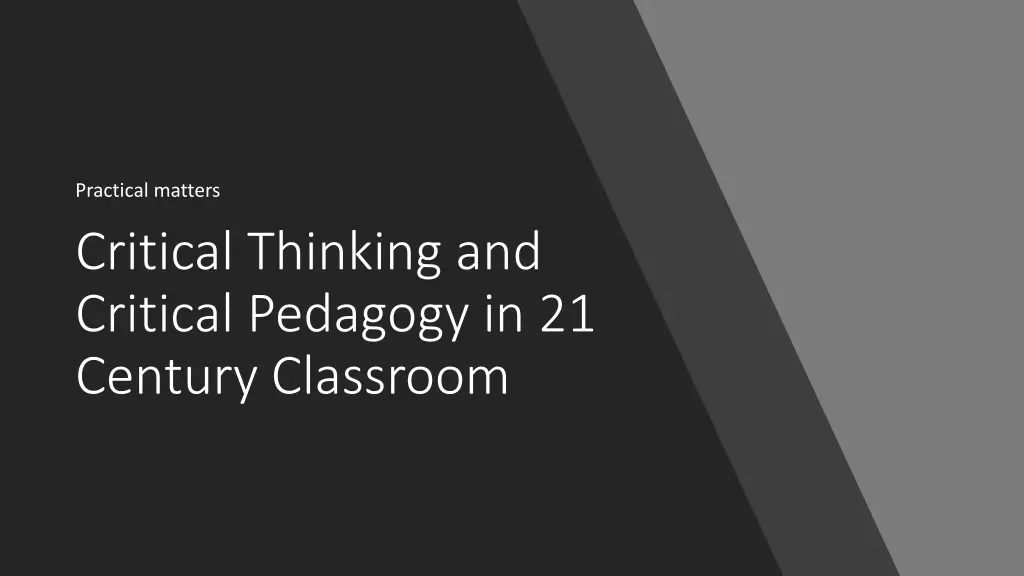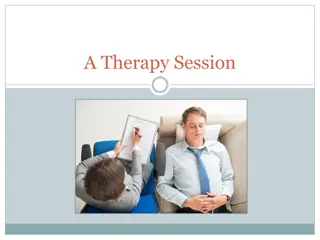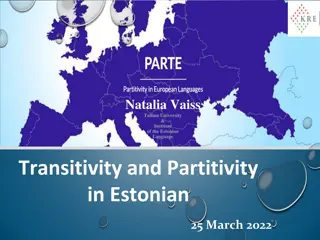
Practical Solutions for Critical Thinking and Pedagogy in 21st Century Classroom
Explore the relationship between critical thinking, pedagogy, and societal power dynamics, emphasizing the importance of fostering a critical capacity in citizens to resist unjust status quos. Dive into the contrasting viewpoints of Critical Pedagogy and Critical Thinking while considering the Vienna Circle as a historical example of exact thinking. Reflect on traditional learning methods versus the need for enhanced critical thinking in today's complex world. Discover practical solutions and methodologies for educators to promote critical thinking and combat dogmatic conceptions.
Download Presentation

Please find below an Image/Link to download the presentation.
The content on the website is provided AS IS for your information and personal use only. It may not be sold, licensed, or shared on other websites without obtaining consent from the author. If you encounter any issues during the download, it is possible that the publisher has removed the file from their server.
You are allowed to download the files provided on this website for personal or commercial use, subject to the condition that they are used lawfully. All files are the property of their respective owners.
The content on the website is provided AS IS for your information and personal use only. It may not be sold, licensed, or shared on other websites without obtaining consent from the author.
E N D
Presentation Transcript
Practical matters Critical Thinking and Critical Pedagogy in 21 Century Classroom
The Vienna Circle (1924-1936) The Vienna Circle stood in the center of that extraordinary period of intellectual flourishing: a shining example of exact thinking, set against a backdrop of wild fanaticism and maniacal stupidity. (Karl Sigmund, 2017, p.8).
Antipodes of Critical Thinking Maniacal stupidity, wild fanaticism, delusion, pseudoscience, dogmatic conceptions, errors of perception, false memories, great conspiracy thinking, fake news, scams, urban legends the list goes on
Easier times? Newspaper TRUTH
Critical Thinking or Critical Pedagogy? Critical Pedagogy Critical Pedagogy tradition, which sees society as fundamentally divided by relations of unequal power. Critical Pedagogues are specifically concerned with the influences of educational knowledge, and of cultural formations generally, that perpetuate or legitimate an unjust status quo; fostering a critical capacity in citizens is a way of enabling them to resist such power effects. Critical Pedagogues take sides, on behalf of those groups who are disenfranchised from social, economic, and political possibilities(Burbules, 1999) Critical Thinking Many Critical Thinking authors would cite similar concerns, but regard them as subsidiary to the more inclusive problem of people basing their life choices on unsubstantiated truth claims a problem that is nonpartisan in its nature or effects. For Critical Thinking advocates, all of us need to be better critical thinkers, and there is often an implicit hope that enhanced critical thinking could have a *general* humanizing effect, across all social groups and classes. (Burbules, 1999)
Ready Made Images, Ready-Made Knowledge Traditional learning activity reduces to the process of assimilating ready-made knowledge, ready-made information, and ready-made conceptions, i.e. it is realized as the activity of the embodying of ready-made images in language and inversely of the visualization of verbally formed conceptions. (Il enkov, 1974, Activity and Knowledge)
Practical solution for teachers. Lie detector methodology
Freeing ourselves from dogmatic conceptions AND READY MADE IMAGES! Real thinking is formed precisely when and only when the work of language is indissolubly joined to the work of the hands the organs of direct-object activity. hands making things, i.e. changing obstinate, intractable, and capricious matter. Only thus can we observe its objective nature independent of ready-made images its objective character or stubbornness. Only thus does the object reveal itself as the thing in itself, compelling us to reckon with it ..
Examples from Vygotskys ZPD (oral, inner and written speech, spontaneous and systemic concepts)





